Eriocephalus
Eriocephalus L.
Family: Asteraceae
Common names: wild rosemary (Eng.); kapokbos, wilderoosmaryn (Afr.)
Introduction
Highly aromatic shrubs which are most distinctive when covered in fluffy white fruiting heads from late spring to early summer. Thus the vernacular name, kapokbos (Afrikaans for snow bush), is applied to all species within the genus. One species, Eriocephalus africanus L., is already widely utilized in gardens and parks. We therefore suggest four additional species for consideration in the garden, E. ericoides (L.f.) Druce, E. eximius DC., E. punctulatus DC. and E. racemosus L.

Description
Description
Members of the genus Eriocephalus are woody, evergreen and often aromatic shrubs. The leaves are simple, quite small and covered with pitted glands. The flowerheads may or may not have outer ray florets, which if present are usually white or in some species pink. After flowering, long white hairs develop in the heads so that they have the appearance of fluffy white cotton balls. Flowering time: flowering strongly corresponds to rainfall so that plants in the winter- rainfall region flower from July to September and those in the summer- rainfall regions from January to April.

E. ericoides lacks obvious outer ray florets (petal-like outer flowers) in flower heads, which are borne on short peduncles and usually arranged in racemes.
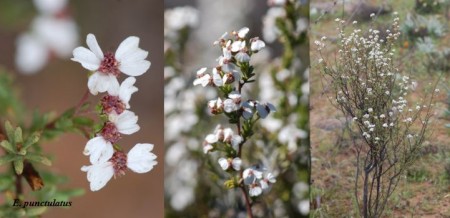
E. punctulatus is a more erect shrub that flowers profusely, bearing bright white ray florets.

E. eximius has a compact growth habit, striking close- set silvery leaves and flowerheads with pink ray florets.
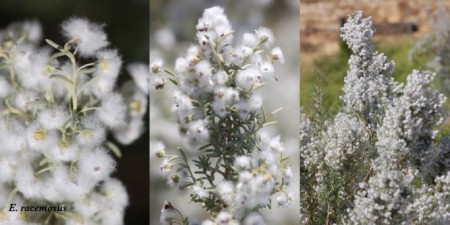
E. racemosus is a very large dense shrub with narrow silvery leaves. The discoid heads are arranged in dense racemes, so that the plants are covered in cotton-like balls.
Conservation Status
Status
E. ericoides, E. punctulatus, E. eximius and E. racemosus are listed as Least Concern (LC) in the Red List of South African Plants (Raimondo et. al., 2009).
Derivation of name and historical aspects
History
The generic name, Eriocephalus, is derived from the Greek words erion meaning wool and kephale meaning head and refers to the distinctive densely woolly fruiting heads. The common name applied to species of this genus, kapokbos (Afrikaans - snow bush), refers to the white fluffy fruiting heads that cover the bush, giving the plant the appearance of being covered in snow. This vernacular name is applied to all Eriocephalus species.
Ecology
Ecology
These plants are readily browsed by livestock and, in combination with other aromatic Karoo shrubs, contributes to the distinctive taste imparted onto the meat, particularly the famous so-called Karoo lamb from these regions.
Uses
Use
Many of the species of Eriocephalus have been used medicinally for their diaphoretic or diuretic properties (Watt & Breyer-Brandwijk). Eriocephalus ericoides is the most widely used species, with several traditional uses. To ripen measles, an infusion is used together with Angora goat droppings.
To relieve chest ailments in children, an infusion of the seed hairs and a couple of green twigs together with a few drops of harlemensies (derived from the name Haarlem Essence ) is used. An infusion of kapokbos with bitterbos is used in a drink to cure colds (Van Wyk et al., 2008).
A well known essential oil, Cape chamomile, is distilled from Eriocephalus tenuifolius, a close relative of E. punctulatus. It is used in aromatherapy for its anti-inflammatory, anti-allergic, antidepressant and antiseptic properties (Sandasi et al., 2011).
Growing Eriocephalus
Grow
To our knowledge, only E. africanus and E. racemosus have been cultivated for the horticultural trade. However, the aromatic nature and medicinal uses of E. ericoides could make it a valuable inclusion in herbal or aromatic gardens.
Eriocephalus punctulatus and E. eximius are in our opinion more attractive with their rayed flowerheads and should certainly be considered for inclusion in the garden. E.riocephalus punctulatus is a prolific flowerer and is covered in a mass of pure white flowerheads in spring, and like the other species also looks good for several weeks thereafter while in fruit. The neat compact growth and beautiful silvery leaves of Eriocephalus eximius could make a very striking semi-formal hedge plant. It also bears very large flowerheads with unusual silvery bracts and pink ray florets.
Species
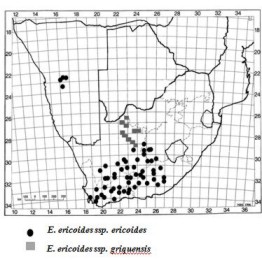
Eriocephalus ericoides is the most widely distributed species of Eriocephalus and is subdivided into two subspecies, E. ericoides subsp. ericoides and E. ericoides subsp. griquensis. The former thrives in the stony clay and sandy flats from Namibia to the Free State and the Northern, Western and Eastern Cape. The latter is restricted to the Northern Cape, stretching from the Orange/Gariep River to near the Botswana border.
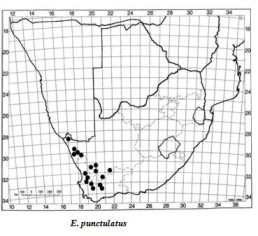
E. punctulatus is restricted to the winter- rainfall region (Greater Cape Floristic Region) and occurs from Namaqualand south to the Roggeveld and Witteberg mMountains (Mu ller et al., 2001)
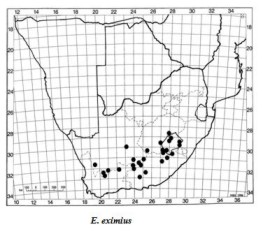
Eriocephalus eximius is restricted to high mountainous areas along the Southern Great Escarpment.
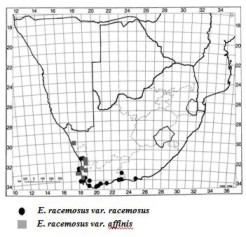
E. racemosus is found on sandy soil along the coast extending from Hondeklip Bay to Melklbosstrand and Port Elizabeth to Lambert's Bay. There are 2 varieties; E.racemosus var. affinis extends from Hondeklip Bay to Melkbosstrand and E .racemosus var. racemosus is found from Port Elizabeth to Lambert's Bay.
References
- Goldblatt, P. & Manning, J.C. 2000. Cape plants. A conspectus of the Cape flora of South Africa. Strelitzia 9. National Botanical Institute, Cape Town.
- Mu ller, M.A.N., Herman, P.P.J. & Kolberg, H.H. (2001). A taxonomic revision of the genus Eriocephalus (Anthemideae-Asteraceae) in southern Africa. Flora of southern Africa 33,4,1: 1 63.47-49
- Raimondo, D., Von Staden, L., Foden, W., Victor, J.E., Helme, N.A., Turner, R.C., Kamundi, D.A. & Manyama, P.A. (eds). (2009). Red List of South African Plants 2009. Strelitzia 25. South African National Biodiversity Institute, Pretoria.
- Sandasi, M., Kamatou, G. P.P., & Viljoen, A.M. (2011). Chemotaxonomic evidence suggests that Eriocephalus tenuifolius is the source of Cape chamomile oil and not Eriocephalus punctulatus, Biochemical Systematics and Ecology 39:328- 338.
- Trinder-Smith, T.H. (2003). The Levyns guide to the plant genera of the southwestern Cape. Contributions from the Bolus Herbarium No. 21.
- Van Wyk, B-.E., dDe Wet, H. & Van Heerden, F.R. (2008). An ethnobotanical survey of medicinal plants in the southeastern Karoo, South Africa, South African Journal of Botany 74: 696 704.
- Watt, J.M & Breyer-Brandwijk, M.G. (1962). Medicinal and poisonous plants of southern and eastern Africa, edn 2. Livingstone, Edinburgh.
Credits
Bronwynne Busch & Anthony R. Magee
Compton Herbarium
October 2012
Plant Attributes:
Plant Type: Shrub
SA Distribution:
Soil type:
Flowering season:
PH:
Flower colour:
Aspect:
Gardening skill:
Special Features:
Horticultural zones






Rate this article
Article well written and informative
Rate this plant
Is this an interesting plant?
Login to add your Comment
Back to topNot registered yet? Click here to register.